How to Fix CSR8510 A10 Driver Error (Driver is Unavailable)
Some Windows users are reporting that they’ve suddenly lost the ability to use their Bluetooth USB adapter (dongle). Affected users are reporting that the Bluetooth Settings have suddenly disappeared, Device Manager shows an error related to the CSR8510 A10 Driver and when investigating the Bluetooth dongle inside Connected devices it showed up as ‘Driver is unavailable‘.
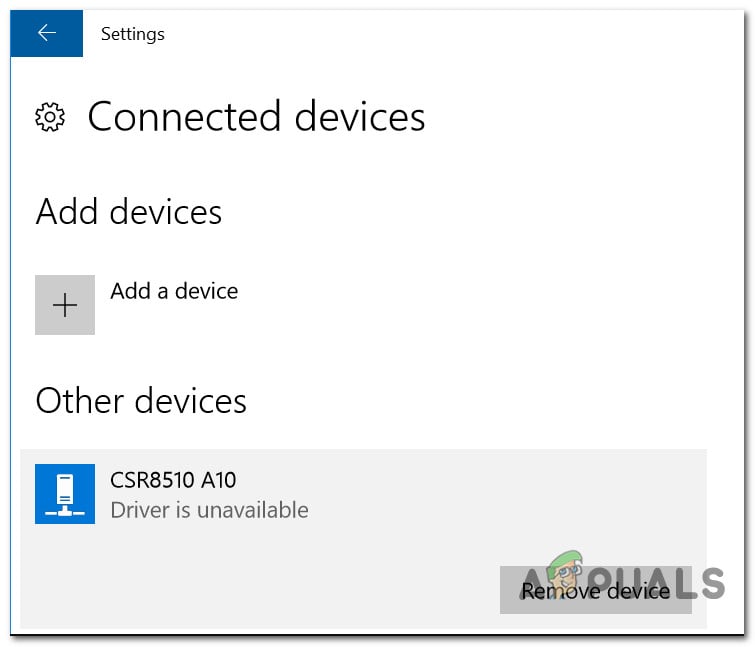
After investigating this particular issue thoroughly, it turns out that there are several different causes that might be the underlying issues of this error code. Here’s a list of potential culprits that might be responsible for this issue:
- Outdated driver version – One of the most common causes that will cause this problem is a severely outdated driver that is breaking the Bluetooth functionality on Windows 10. If you find yourself in this scenario, you can use Device Manager to update to the latest version available.
- Incompatible Bluetooth driver – As it turns out, it’s also possible to see this error if your computer is trying to use a driver that is not fully compatible with your OS version. In this case, you should be able to fix this issue by using Device Manager to install a generic driver equivalent.
- Device Manager is unable to install the correct driver version – According to some affected users, you might see this error occurring due to the fact that your OS is trying to install an incompatible driver version. IN this case, you can use a 3rd party driver update utility to install the correct version automatically.
- Critical Bluetooth services are Disabled – If you have manually disabled some Bluetooth-related services or you’re using a service optimizer app, you might see this issue occurring because the Bluetooth Support Service and Bluetooth HandsFree Service entries are disabled. In this case, you can fix the issue by modifying the startup type of these 2 services.
- Missing Bluetooth Stack installation – In case you’re encountering this issue on a Windows 7 computer, chances are you’re seeing this error due to the fact that there’s no architecture to bridge the Bluetooth connection. If this scenario is applicable, you should be able to fix the issue by installing the Bluetooth Stack program.
- System file corruption – Under certain special circumstances, you might expect to see this error occurring due to some kind of corruption that is affecting the Bluetooth driver or some associated dependencies. In this case, your best chance at fixing this issue is to go for a repair install or clean repair procedure.
Now that you know every potential culprit, there’s a list of methods that other affected users have successfully used to fix the driver issue related to CSR8510 A10:
Method 1: Updating the Driver via Device Manager
One of the first things you can do if you find yourself in this scenario is to use Device Manager to see if you can update the current version of the CSR8510 A10 to the latest iteration available. This might be effective in situations where the issue has just started occurring after Windows Update installed a pending infrastructure update.
Several affected users have confirmed that they were able to update the driver via Device Manager and they were able to use their Bluetooth dongle normally once the next computer startup was complete.
If you haven’t tried doing this yet, follow the instructions below to update the CSR8510 A10 driver via Device Manager:
- Press Windows key + R to open up a Run dialog box. Inside the text box, type ‘devmgmt.msc’, then press Enter to open up Device Manager.

Opening Device Manager - Once you’re inside Device Manager, scroll down through the list of device types and expand the drop-down menu associated with Bluetooth.
- With the Bluetooth tab expanded, right-click your CSR8510 A10 driver and choose Update driver from the context menu that just appeared.

Updating the Bluetooth driver - At the next screen, click on Search automatically for updated driver software from the available options>
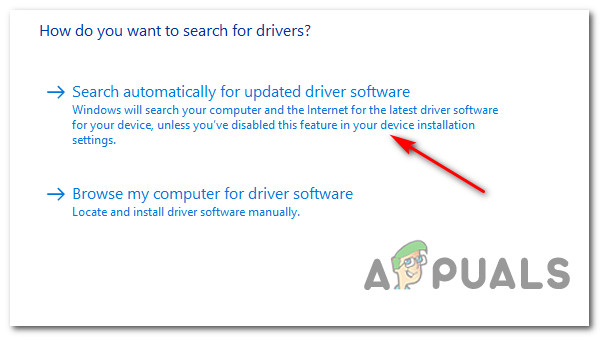
Search for new versions of the Bluetooth driver - Follow the on-screen prompts to complete the installation of the new driver version (if a new version is found), then restart your computer at the end of this procedure if you’re not prompted to do so automatically.
- Once your computer boots back up, attempt to use the Bluetooth functionality brought about by your USB dongle and see if the issue is now fixed.
In case the driver state still shows an error associated with CSR8510 A10, move down to the next potential fix below.
Method 2: Installing a generic Bluetooth Driver
According to some affected users, you might be able to fix this issue by replacing the current driver used by the CSR8510 A10 device with a generic equivalent supplied by Microsoft. A lot of affected users have confirmed that this method was the only thing that allowed them to fix the ‘Driver is unavailable‘ after their Bluetooth dongle has stopped working.
We didn’t manage to find an official explanation, but affected users are suspecting that this method is effective because it goes around a native driver conflict introduced along with a Windows Update.
If you haven’t tried replacing the dedicated driver with a generic equivalent, follow the instructions below to do so:
- Press Windows key + R to open up a Run dialog box. Inside the text box, type ‘devmgmt.msc’ and press Enter to open up Device Manager. When you’re prompted by the UAC (User Account Control), click Yes to grant access.
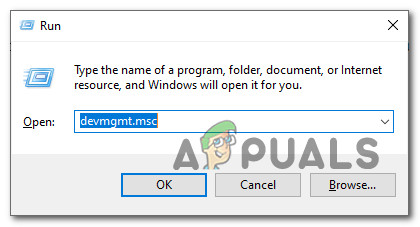
Accessing Device Manager - Once you’re inside Device Manager, scroll down through the list of device types and expand the drop-down menu associated with Bluetooth. Once you’re inside, right-click on your Bluetooth dongle and choose Update driver from the context menu that just appeared.
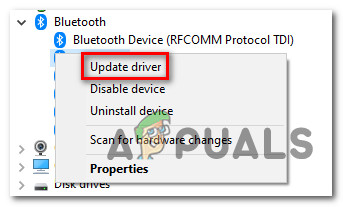
Updating the Bluetooth driver - On the next screen, click on Browse my computer for driver software from the context menu that just appeared.
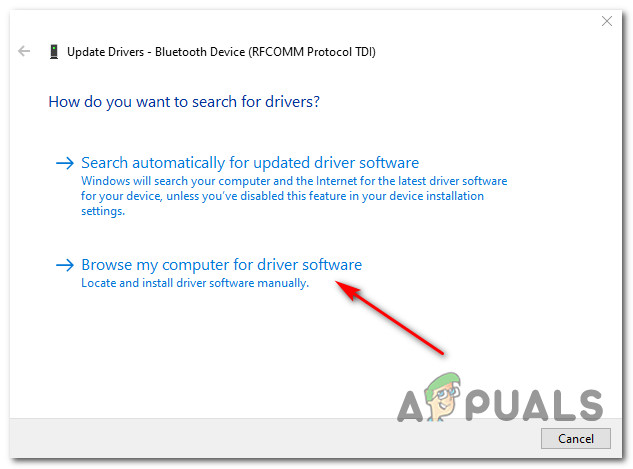
Installing a generic Bluetooth driver - Once you get to the next screen, click on Let me pick from a list of available drivers on my computer.
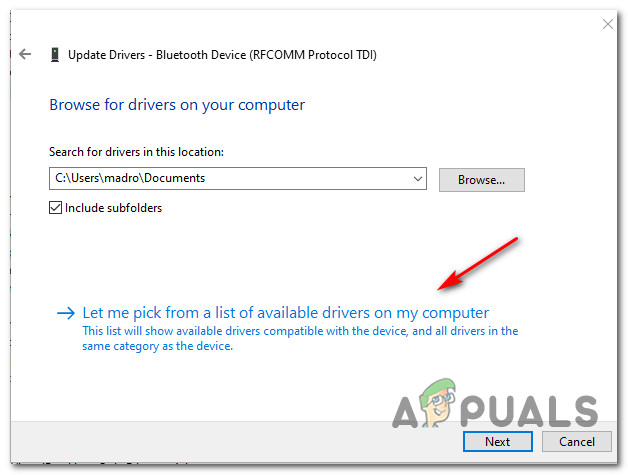
Picking the generic driver manually - Next, select a generic choice from the list of available drivers. If you have to choose between multiple options, choose the entry with the Blue Bluetooth logo and hit Next before following the on-screen prompts to complete the installation of the generic driver, then restart your computer.
If you are still encountering the same CSR8510 A10 Driver error even after making the switch to a generic Bluetooth version, move down to the next potential fix below.
Method 3: Using the Auslogics Driver Updater in Compatibility Mode
If the two methods that are using Device Manager above haven’t work in your case, the next thing you should try is to use the Auslogics Driver Updater to install the latest driver version for the CSR8510 A10 device.
However, if you’re on Windows 10, you might need to open this program in Compatibility mode with Windows 7 in order to avoid an OS-specific glitch. Several affected users have confirmed that this was the only thing that allowed them to fix the CSR8510 A10 Driver error.
Follow the instructions below to deploy the Auslogics Driver Update to update the USB dongle driver and fix the ‘Driver is unavailable‘ error:
- Open your default browser and access the download link of Auslogics Driver Updater to download the latest version. As soon as you access this link, the download should begin automatically.
- After the download of the driver updated utility is complete, don’t open it immediately if you’re on Windows 10. Instead, navigate to the location where you downloaded it, right-click on it and choose Properties from the context menu that just appeared.
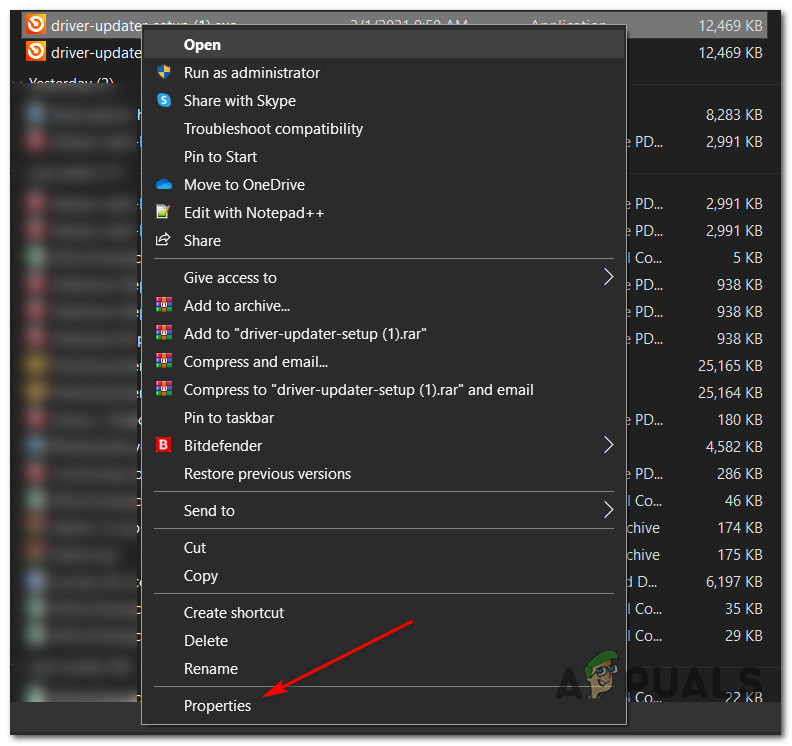
Accessing the Properties screen - Once you’re inside the Properties screen of the setup executable, access the Compatibility tab, check the box associated with Run this program in compatibility mode, then select Windows 7 from the list of available options.

Running the installer in compatibility mode - Click Apply to save the changes, then double-click on the installer and follow the on-screen prompts to run the driver updating software and update the Driver version to the latest available.
Note: When you’re prompted by the UAC (User Account Control) prompt, click Yes to grant admin access. - Once the driver version is updated, restart your computer and see if the issue is now fixed.
In case you are still seeing the same kind of , move down to the next potential fix below.
Method 4: Enabling the Bluetooth Handsfree service and Bluetooth Support service
As it turns out, you can also expect to see this issue if a manual user interaction or an optimizing application has ended up modifying the Startup Type of a couple of Bluetooth-related services – Bluetooth Support Service and Bluetooth HandsFree Service.
Whether you disabled this yourself or a program did it for you, you should be able to fix the issue by accessing the Services screen to set the startup type of both to Automatic.
If you haven’t tried this fix yet and this scenario looks like it could be applicable, follow the instructions below to modify the startup type behavior of the Bluetooth Support Service and Bluetooth HandsFree Service:
- Press Windows key + R to open up a Run dialog box. When you’re prompted by the text box, type ‘services.msc’ and press Enter to open up the Services screen. If you’re prompted by the UAC (User Account Control), click Yes to grant admin access.
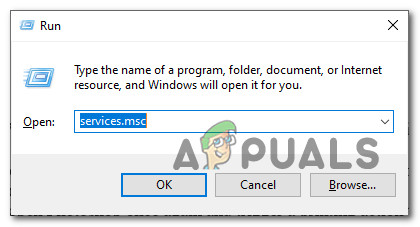
Accessing the Services screen - Once you’re inside the Services screen, scroll down through the list of services and locate the Bluetooth Support Service. When you see it, right-click on it and choose Properties from the context menu.

Accessing the Properties screen of the Bluetooth Support Service - Inside the Properties screen of the Bluetooth Support Services Properties screen, access the General tab and change the Startup type to Automatic using the drop-down menu that just appeared.
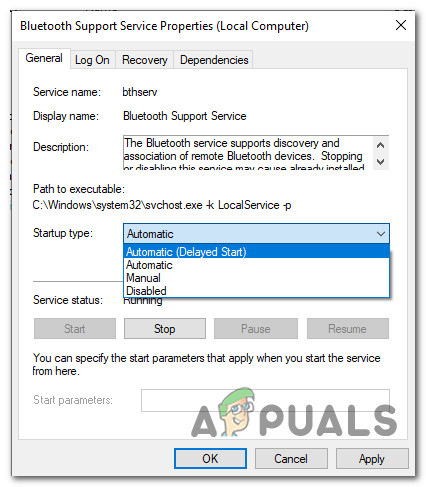
Modifying the Automatic Startup type of the Bluetooth Support service - Click Apply to save the changes, then return to the root screen of Services and repeat step 2 and 3 with the Bluetooth Handsfree Service before saving the changes and restarting your computer.
- Once your computer boots back up, see if you are able to use your Bluetooth dongle.
In case the associated driver is still showing the CSR8510 A10 Driver error, move down to the next potential fix below.
Method 5: Installing the Bluetooth Stack program
If you’re encountering this issue on Windows 7 with CSR drivers, you might be seeing the CSR8510 A10 Driver error due to a driver inconsistency related to a missing Stack architecture.
Several affected users encountering the same kind of error have reported that they managed to fix the issue by installing the Toshiba Bluetooth Stack program on their computer – This program is confirmed to work with the vast majority of CSR drivers and can be installed outside the Toshiba ecosystem.
If this scenario is applicable, follow the on-screen instructions to complete the installation of the Bluetooth Stack program supplied by Toshiba:
- Open your default browser and access the download page of the Bluetooth Stack.
- Once you’re inside, click on the Download button to download the latest version of the program.

Downloading the Bluetooth Stack driver - Once the download is complete, double-click on the installer and click Yes if you’re prompted by the UAC (User Account Control) prompt.
- Inside the Setup screen, follow the on-screen prompts to complete the installation of Bluetooth Stack, then restart your computer at the end of this procedure.
- After you manage to install the Bluetooth Stack Program and the next startup is complete. At the next startup, it should detect the Bluetooth Adapter and bridge the adapter allowing it to run without issues.
In case this method didn’t fix the CSR8510 A10 Driver error in your case, move down to the next potential fix below.
Method 6: Refreshing every Windows component
In case none of the methods above have worked for you, you can safely assume that you’re either dealing with a faulty USB dongle or you’re dealing with some type of underlying system file corruption that cannot be fixed conventionally.
If this scenario is applicable, you should be able to fix the problem by essentially refreshing every involved Windows component ensuring that every potentially corrupted Windows file is replaced with a healthy equivalent. When it comes to doing this, you have 2 ways forward:
- Clean install – If you’re looking for the simplest procedure out of the bunch and you have already backed up your personal data or you don’t care about losing the files you’re currently stored on the OS drive, this should be the first choice for you. You can perform a clean install procedure without having to insert or plugin an installation media (directly from the GUI menu of Windows).
- Repair install – In case you don’t mind a tedious procedure or you don’t have the time to backup your OS drive, a repair install should be your first choice. This procedure will ensure that you get to keep your personal files, applications, games, and even some user preference. However, you need to use compatible installation media in order to deploy this kind of fix.





